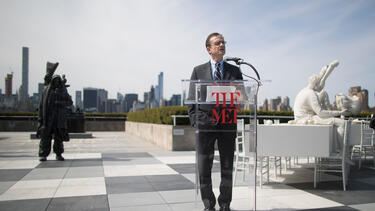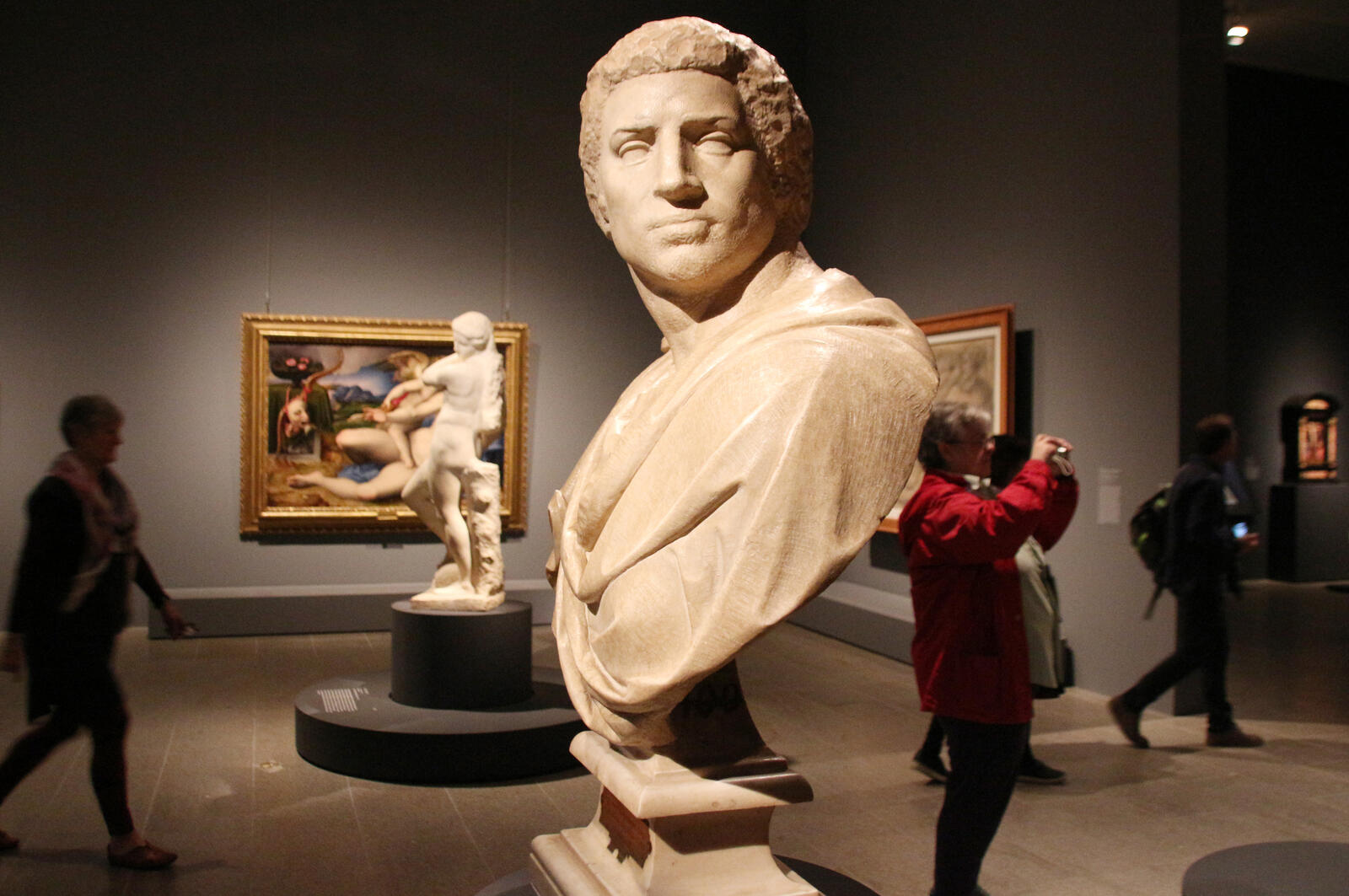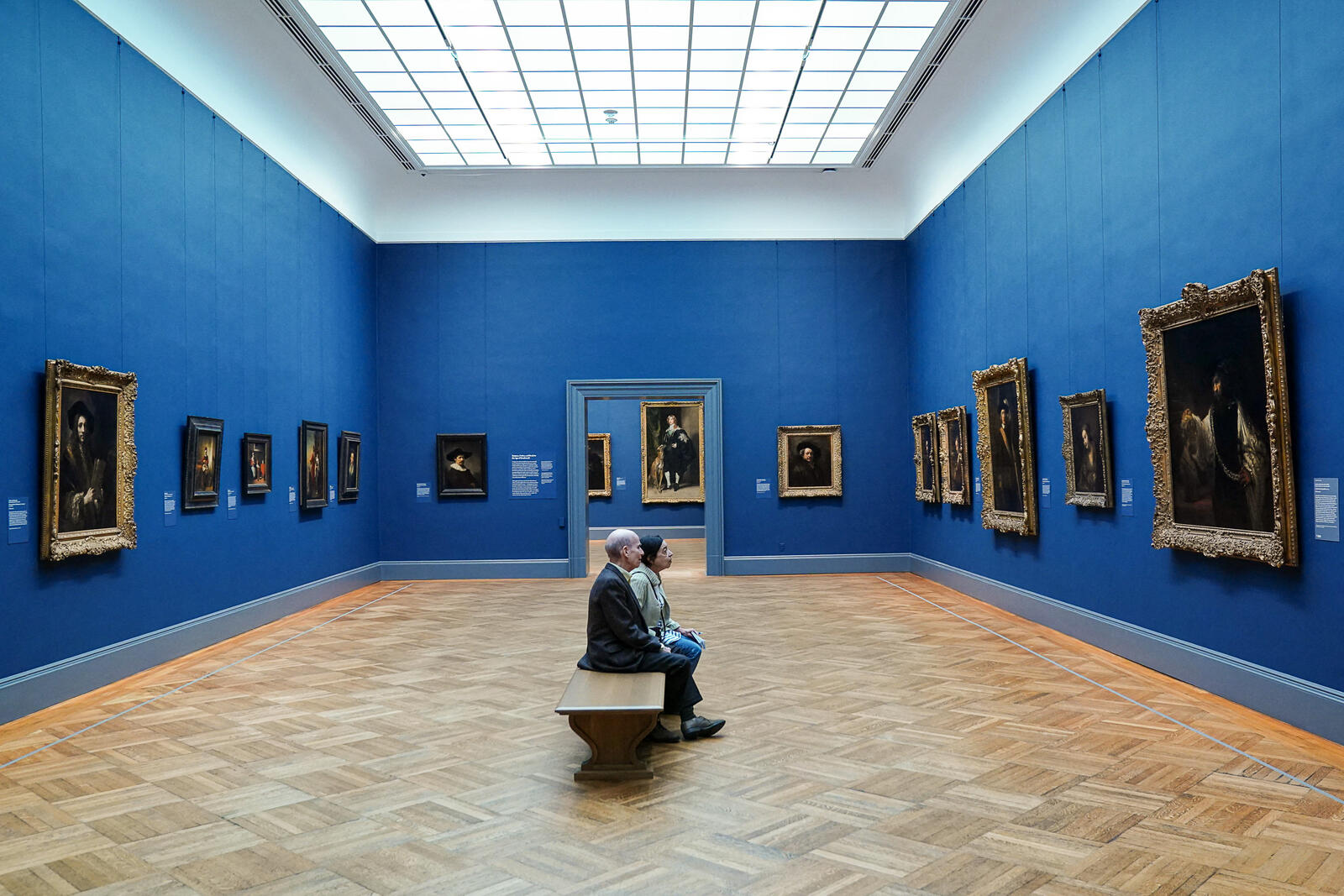Why Do Museums Matter?
Daniel Weiss ’85, an art historian and the former president and CEO of the Metropolitan Museum of Art, discusses the complexities, joys, and challenges of leading mission-driven organizations.

Daniel Weiss, president of the Metropolitan Museum of Art, speaking in the Iris and B. Gerald Cantor Roof Garden in 2017.
Q: Why do museums matter?
Art is elemental. Civilizations across the planet and across time have used art to tell stories, construct identity, and help us to understand our place in the world. Human beings have also created and stewarded collections of art, in various ways, going back to the very beginnings of the human condition. Caves had paintings in them before societies had language or agriculture.
In the 17th and 18th centuries, there was an Enlightenment notion that works of art could be gathered and presented to edify the public. That was the source of museums like the Louvre and the British Museum, but, at this point, the concept of the museum has become much bigger and more important.
Museums are engines of civic engagement. They bring us together as disparate individuals in shared purpose. They allow us to discuss, debate, and find capacity for agreement across difference. If we can model that in an art museum, then maybe we can learn to do it in government and in the larger society.
Museums are also engines of the economy. The Metropolitan Museum of Art sees 7 million visitors a year. It’s the number one tourist attraction in New York City and an extraordinarily powerful source of economic vitality for the whole city.
Across the country, there are more than 35,000 museums. They account for 750,000 jobs and generate $50 billion in economic activity. Museums today are very healthy, notwithstanding the fraught political and cultural issues surrounding them.
For all those reasons, museums matter—and perhaps more now than in the past because their role has become more central to our civic lives.
Q: Given their importance, what does it take for museums to be successful as organizations?
Museums, like universities, are mission-driven institutions, which means that fulfillment of their purpose is to realize a set of objectives that are not directly tied to profitability but are tied to sustainability. If a museum isn’t able to balance its budget, take care of its collection, and invest in its future, it cannot survive, and the leadership is not fulfilling its obligations.
Half of the job of running a museum is running a commercial enterprise that has all of the issues that any business has. We have revenue generating activities, we have cost management, we have staff and personnel issues. We do marketing and communications. We manage facilities. All the elements that go into running any commercial enterprise live in a museum.
But the other half is the mission side, which is fundamentally inefficient from a financial point of view. Exhibitions, publications, and generating new knowledge in the form of scholarship are all incredibly expensive.
We did an exhibition on Michelangelo. It required seven years of planning and negotiating loans to borrow works of art from all over the world. Throughout that time, we invested in preparing scholarly materials, developing publications, and designing and building an exhibition that was on public view for three months. It was of great importance in the study of Michelangelo. It advanced the mission of the Met in material ways. It was not a good financial decision.

The Metropolitan Museum during the exhibition “Michelangelo: Divine Draftsman & Designer” in 2017.
Holding those two halves in balance is part of the joy and the challenge of this kind of leadership role. You have to balance the budget every year, but you also have to invest in things that are ultimately inefficient but deliver on the organization’s purpose. I think this type of values-driven leadership requires more of a CEO than a private sector role.
Museums, again like universities, are what we call perpetual institutions, which means that the obligation is to run them forever. The decisions that we make have to withstand scrutiny both in the present and over the long term.
Q: How do leaders balance the practical and aspirational—this year and perpetuity?
One of the fundamental obligations of any leader is to understand your organization’s mission. It’s not a simple question. The Met’s mission is not the same exactly as the Museum of Modern Art or the Guggenheim or the Smithsonian. The Met aims to collect, present, and study the works of art of, ideally, all cultures across all of time. As a leader, you have to understand the mission at a deep level and then embed all of the choices you make within the context of what advances that mission.
The other leadership principle I’m a great believer in is the idea of shared governance. Mission-driven institutions need all the constituencies that care about and have a vested interest in the institution to participate in decision-making.
The most obvious example of that is a university. If the students, faculty, and alumni are not interested in supporting what the president wants to do, the president is done. In mission-driven institutions it’s not a directive from the executive leader that delivers progress. Progress comes from doing the work to bring constituencies and communities together around shared purpose.
Q: Would you give an example?
Changing the Met’s pay-as-you-wish admissions policy is a very good example. For context, there’s a long-standing, widely held impression that the Met is very wealthy. When I was a student at Yale SOM, I took a class with the director of the Yale University Art Gallery. He argued that the Metropolitan Museum of Art should be free given how rich it is.
I am very sympathetic to making museums accessible. As an undergraduate student at George Washington University, I found myself visiting the National Gallery very often. It wasn’t far from where I lived, and it was free. Through those visits, I developed a relationship with the museum and the art. Even now, whenever I’m in Washington, I go to walk through spaces that I remember so well and see the paintings that I love. It feels like visiting an old friend.
But when I got to the Met in 2015, I discovered that the museum’s budgets were very constrained. In fact, the financial situation was serious and there was a substantial backlog of deferred maintenance.
As any good MBA would do, I took a look at all of our sources of revenue. I discovered that in the 10 years prior, the average amount people paid under the pay-as-you-wish admissions policy had declined by 67%.
That was not sustainable, though when I started to explore alternatives, nobody was in favor of a change. It was seen as a third rail. But we worked really hard to listen, engage, and share with the staff, the board, and the city government what was at stake if we didn’t get it right. We had something like 45 open meetings just within the museum to talk with the staff. It took over a year.
Ultimately, we settled on the idea that nonprofit organizations should rely on co-investment—those who benefit from an institution have an obligation to support it at some level. We sought an admissions policy that reflected that.
The Metropolitan Museum of Art is an independent nonprofit. But New York City owns the building we occupy. The city and state do provide some funding, so residents of New York are supporting the museum through their tax dollars. As such, we maintained the pay-as-you wish option for New York residents. If you live in New Jersey or Connecticut or Kansas or Paris, there is the expectation you pay admission to visit an institution that is owned and supported by all of us.
The change was certainly controversial politically, but when it was implemented, there was a bit of news for a week or two, and then people settled in. We saw no diminution of visitors. We solved the revenue problem we were seeking to solve.
And our stakeholders supported the change. The process we went through was necessary for that good outcome. Shared governance can be very cumbersome, but it’s an essential component of good decision-making.
Q: Being president and CEO of the Metropolitan Museum of Art sounds glamorous. “Deferred maintenance” isn’t a phrase I associate with glamour.
The museum, which is the largest art museum in the world, had allowed its physical plant to deteriorate. When I arrived, included in the serious and substantial deferred maintenance were the skylights over the European painting galleries—several acres of skylights. They had been installed in the 1930s. They were due to be replaced during the term of President Lyndon Johnson but hadn’t been. They were leaking, posing a hazard to the collections below. The cost to replace them was $150 million. There was no prospect for philanthropic support—skylights are not the kind of thing donors pay for. Even so, we had to address the problem.
One of the first things I learned when I arrived at Yale SOM was the concept of opportunity cost. Ever since, in my various leadership roles, I’ve been mindful that decision-making must be about genuine trade-offs.

A Metropolitan Museum gallery of Rembrandt paintings in November 2023 after a five-year, $150 million renovation.
To fix the leaking skylights, we took on $150 million of debt. I was very aware that the money that went into paying that interest expense could not be used for other desirable initiatives or capital projects. But if you don’t do what’s needed, all you’re really doing is burdening the next generation with problems you weren’t up to solving.
I felt a moral obligation to pass on the institution to my successor stronger than I found it, with a budget that is balanced and resources in place for investment. I did that, and I’m very proud of it.
Q: How did you come to art as something that mattered to you?
My parents divorced when I was very young. My father moved to Puerto Rico. For many years, I would excitedly get on a plane for two weeks with him in a tropical paradise.
On the walls in his apartment, he had paintings that he had done. I thought they were beautiful. They moved me. And I associated them with a time that was very meaningful and positive. As I got older, my tastes in art evolved and became more sophisticated, yet I still love those paintings. My father eventually gave me several. They’re on the walls of my house today.
I think I was receptive to art because of my father’s artistic interests. But I started college thinking I would study political science. Then there was a young woman I was interested in. She was taking an art history class. I didn’t even know what that was, but I signed up too, just so I could spend more time with her.
The professor was inspiring. He was incredibly articulate. His passion and intellectual seriousness were evident. His approach to life resonated with me. I kept studying with him. I fell in love with art and the discipline of art history. He was a medievalist. Eventually I became a medievalist, too. And that woman I was pursuing—I’ve now been married to her for 44 years.
Q: That makes sense as the path of an art scholar. Where did the interest in leadership come in?
Early on, I wasn’t sure what kind of a career I wanted—perhaps in academic art history or perhaps working in a museum. I really loved art; I had an MA in art history. But I had also held a leadership position at the Kennedy Center running the retail sales business. I cared about leadership. I believe that it mattered. I was really interested in what makes organizations effective.
As I was struggling with whether to focus on art or leadership, as I was doubting myself—why can’t I keep focused on one career or another? —someone I knew was applying to business school and described Yale SOM. The school’s recognition that leadership is more than just managing private businesses; the focus on core skills that let you work successfully across sectors—it sounded tailored to me, and it was lucky that I got in, because it was the only school that had a program like that. The rest is history. I went and the program delivered on its promise.
But that internal struggle continued until I had one of the most important conversations of my life with a classmate, David Paltiel, who is now on the faculty at the Yale School of Public Health. He said, “You’re not understanding yourself the right way. You have intensity of focus on the things you care about, and you have wide-ranging interests. Your career is going to go like that. Instead of fighting it, embrace it. Throw yourself into what you care about. It will sort itself out.” Recognizing that my love of art and commitment to leadership could be complementary felt liberating to me.
Q: And you did throw yourself into both. After Yale SOM, you worked in consulting. Then you returned to academia for a PhD.
I took a job at Booz Allen because I knew I’d learn a ton through applying the tools I’d learned at Yale SOM. I came to understand the issues companies face. I learned how to communicate with business leaders. The skills that I developed and the experiences I had in those four years of consulting have served me through the rest of my career.
And, though it was scary to leave it behind without any guarantee, I went back to get a PhD. I had an academic career. Then when opportunities arose, I led Haverford College and Lafayette College before joining the Met. I feel incredibly lucky to have had the chance to do all of those things.
Yale SOM really helped me to understand the range of what is possible, what kind of leadership skills are necessary to be successful across sectors, and how to bring complementary passions to bear in meaningful ways.
Q: You note that museums are healthy, but it is a tumultuous moment for society. Are you concerned about what is to come?
I have worries about all kinds of issues. I have worries about the state of our society, the nature of our government and its leaders. But I don’t worry about the enduring value of culture. Are we coming to a new iteration of how culture is presented? Perhaps. I don’t know what the next generation of culture is going to look like, but I do know that culture is not going away.
Learn more
Daniel Weiss’s efforts to stabilize the Met’s finances are the subject of a Yale SOM raw case study. Watch a video from the case study: